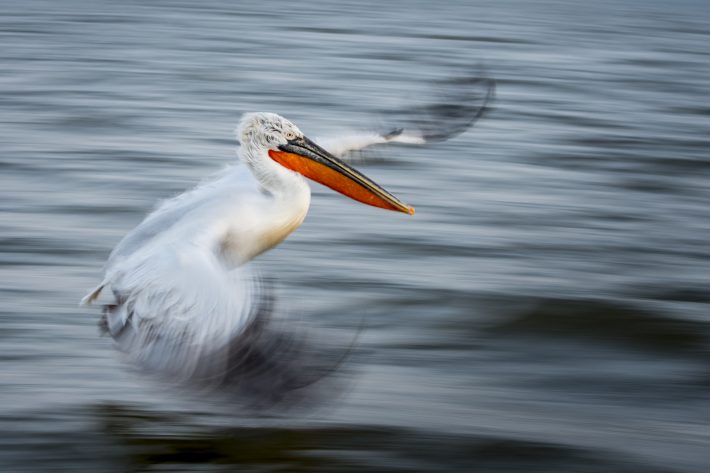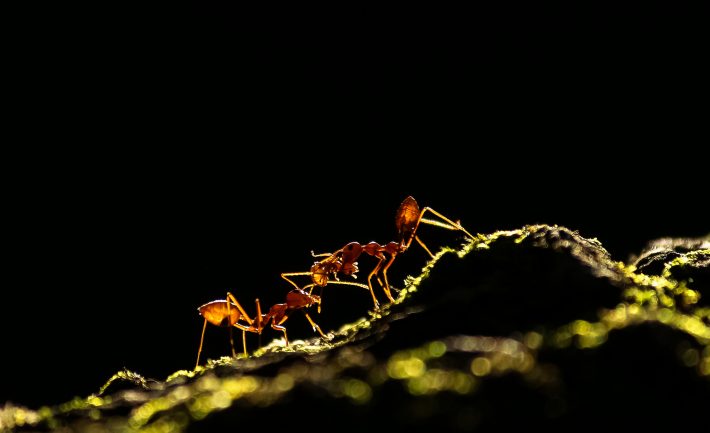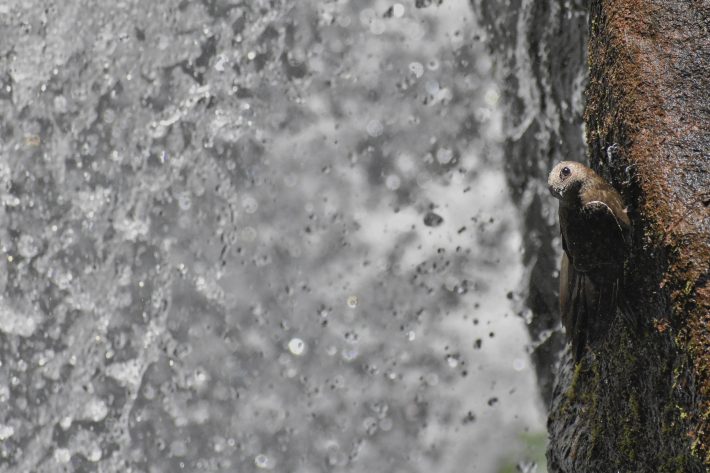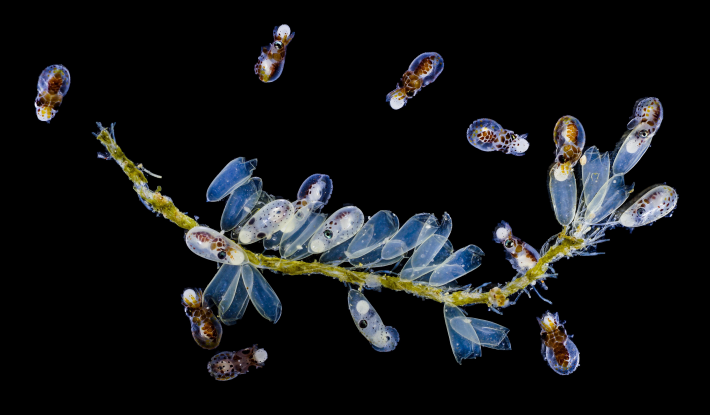Capturing Ecology – Winning images of British Ecological Society photography competition announced

An image of a flying Dalmatian Pelican, taken by Alwin Hardenbol, has been awarded Overall Winner in the British Ecological Society’s annual photography competition, ‘Capturing Ecology’.
The winning images and an additional 16 highly commended images, taken by international ecologists and students, celebrate the diversity of ecology; capturing flora and fauna from across the planet. Subjects range from a showdown between a roadrunner and rattlesnake, flamingos feasting at sunset and a close-up of a friendly humphead wrasse.
On his winning image, Alwin, a PhD candidate at the University of Eastern Finland, said: “I gave this image the title The art of flight because of how impressive this bird’s wings appear in the picture, you can almost see the bird flying in front of you despite it being a still image.
“I used a technique called panning which involves using a slow shutter speed and moving the camera along with the bird as it flies. In a perfect scenario, the background and most of the bird will show blurred movement but the head should be sharp. I took thousands of pictures and while most failed, I was very happy with this shot.”
Winning such a competition as an ecologist provides me with the opportunity to continue combining my research with my passion for nature photography.
Professor Jane Memmott, President of the British Ecological Society, commented: “The photograph captures the movement, grace and beauty of the bird perfectly. Pelicans were one of my favourite birds to watch on trips to the ocean when I worked in Costa Rica as a PhD student and this image reminds me of those days. A challenging photograph to take and a deserving winner.”

“As always, the standard of the photography is impressive, and it was a fun job to look through them all. I congratulate all winners and thank all the participants for their submissions” said Jane.
Alwin also won the ‘People and Nature’ category with an image of a black-legged kittiwake, an internationally vulnerable species, nesting on a decrepit building in Varanger, Norway.
The overall student winner is Pablo Javier Merlo, who is studying Biology at the Nacional University of Córdoba, Argentina. Pablo’s image captures a Great Dusky Swift perched on the steep rocky walls of the Iguazú falls in Argentina. These birds, known as ‘waterfall swifts’ in Latin America, can be found flying among the 80 metre high waterfalls.

Pablo said: “The Iguazú National Park has remarkable importance since it protects a very diverse natural ecosystem, and the waterfall swift is an important icon of Iguazú and its diversity.
“I am very grateful to be selected as one of the winners and feel motivated to continue learning about photography, which is an excellent tool to show our planet’s wildlife and how it relates to its environment.”
The independent judging panel included six highly respected photographers including eminent ecologists and award-winning wildlife photographers.
Among them was Gabriela Staebler, who has a wildlife photography career spanning 30 years. She said: “The standout images show not only great photographic skills, but love and emotion for wildlife. With their impact on people they will contribute to the preservation of nature. Congratulation to the photographers!”

To see more of the winning images follow us on Instagram and Twitter.
Full list of winners:
Overall winner: Alwin Hardenbol, University of Eastern Finland
The art of flight: A panning shot of a Dalmatian Pelican (Pelecanus crispus) in flight. This picture was taken on the lake of Kerkini in Greece as the pelican was flying by.
Overall runner-up: Pichaya Lertvilai, Scripps Institution of Oceanography, University of California San Diego
Hatching: The paralarvae of California two-spot octopus, Octopus bimaculatus, hatching from their egg sacs. The egg yolks attached to their mouths will sustain them for a short period before they have to start hunting to survive.
Overall runner-up: Upamanyu Chakraborty, no affiliation
Ant tale: Weaver ants social behaviour taken in a backlit situation. The colony of Weaver ants is a great example of social behaviour among the animal kingdom. They are also called the ‘ecosystem engineers’ for their roles in maintaining ecosystem..
Overall student winner: Pablo Javier Merlo, Nacional University of Córdoba, Argentina
Waterfall Swift: Cypseloides senex is a species of swift known in Latin America literally as “Waterfall swift”. It can be found on the steep rocky walls (up to 80 meters high) of the Iguazú Falls, flying frequently near and through these waterfalls offering a unique show.
Category 1 – Up Close and Personal
An image displaying the intricacy of nature using close-up or macro photography.
Winner: Michal Smielak, University of New England, Australia
Breath. Adapt. Relax.: Bearded leaf chameleon (Rieppeleon brevicaudatus), with its rather underwhelming “beard” consisting of just a few raised scales. The species is endemic to Eastern Arc Mountains of Tanzania and Kenya. This one was spotted during a night walk in the Udzungwas.
Student winner: Lauren Henly, University of Exeter
Look into my eye: At the end of a dive on the Great Barrier Reef I was lucky enough to have a friendly humphead wrasse (Cheilinus undulates) swim up close to my camera and ‘pose’ for some photos. I was able to show off the intricate maze-like patterns of lines that cover its face.
Category 2 – Dynamic Ecosystems
Demonstrating interactions between different species within an ecosystem.
Winner: Peter Hudson, Penn State University
The Roadrunner’s rattler dance: Roadrunners will kill and eat rattlesnakes but must avoid being struck, so they perform this amazing dance, always moving and keeping beyond striking distance with their wings out and body feathers. This snake survived and moved on – too big and too risky I guess but great to watch.
Student winner: Sam J England, University of Bristol
Into the Lion’s Den: A jumping spider (family Salticidae) sits at the edge of its den, constructed on the underside of a fallen leaf in the rainforests of Costa Rica, as it triumphantly feasts upon its unfortunate insect prey.
Category 3 – Individuals and Populations
A unique look at a species in its environment, either alone or as part of a population.
Winner: David López-Idiáquez, Centre d’Ecologie Fonctionnelle et Evolutive (CEFE-CNRS) and the University of the Basque Country
Last meal of the day: At the saltworks of Villeneuve-lès-Maguelone in the vicinities of Montpellier (France), a group of greater flamingos (Phoenicopterus roseus) feed just before the end of the day.
Student winner: Elena Racevska, Oxford Brookes University
I see you: From the dusty roads of Sainte Luce to the busy streets of Antananarivo, the nightjars evaded me for months. My luck changed on a sunny day in Berenty Reserve, when I finally spotted my quarry. Perfectly camouflaged, perfectly still. Already watching me, long before I even took the shot.
Category 4 – People and Nature
An interesting and original take on the relationships between people and nature.
Winner: Alwin Hardenbol, University of Eastern Finland
Housing for the threatened, A picture of a Black-legged Kittiwake (Rissa tridactyla) nesting on an abandoned, decrepit building in Varanger, Norway.
Student winner: Elena Racevska, Oxford Brookes University
This is our playground, As the day turned to night, mesmerised tourists gathered to witness the baobabs’ grandeur amidst a deep-coloured sunset. The trees stood silent and tall, as they have for centuries. Suddenly, as if out of nowhere, two children appeared. Tumbling through this theatre of shadow and fading light. Claiming their playground.
Category 5 – Ecology in Action
Showcasing the practice of ecology in action
Winner: Peter Hudson, Penn State University
Wolf Fascination: My grad student Ellen being watched by fascinated visitors to Yellowstone as she examines one of her study animals, a wolf killed in a fight for dominance. This female was exiled from the Junction Butte pack after she had killed the pups of the alpha female, her own sister.
Student winner: James Orr, Trinity College Dublin
Constant Flow: This photograph is a panorama made up of multiple long-exposure photographs of the Milky Way above an experimental stream system made up of 128 mesocosms. As part of my PhD, I helped to run a multiple-stressor experiment testing the individual and combined effects of different climate-change stressors on freshwater food webs. Each of the 128 mesocosms, or medium worlds, had a diverse ecosystem from bacteria to fish. Pumps constantly pushed water from the nearby river up to eight main water tanks and then down through our mesocosms for five weeks straight, day and night.
Category 6 – The Art of Ecology
A creative and original take on photography denoting ecology
Winner: Roberto García Roa, University of Valencia
Mouth: A Cope’s Vine Snake (Oxybelis brevirostris) shows a conserved behavior of some reptiles across the Squamata phylogeny. Despite being harmless, they don’t have venom, these snakes open their mouths to scare predators when are discovered. Although they don’t use to attack, they move quickly with the mouth open offering a scenario that many animals finally decide to abandon.
Student winner: Sanne Govaert, Ghent University
Common nettle, foe or friend?: Thanks to humankind, common nettle is a widespread species. It is typically found at disturbed sites with high soil fertility. The hairs of nettle sting, a quite unpleasant experience. However, it is also a host plant of several butterflies. With the right angle of light, it can even look beautiful.
Media contact:
Davy Falkner
Media Relations Officer, British Ecological Society
Email: press@britishecologicalsociety.org
T: +44 (0) 7525 966 919
Like what we stand for?
Support our mission and help develop the next generation of ecologists by donating to the British Ecological Society.